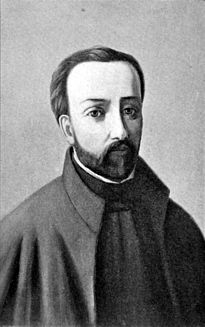Gabriel Lalemant
Saint Gabriel Lalemant | |
|---|---|
 | |
| Jesuit, Missionary and Martyr of Canada | |
| Born | October 3, 1610 Paris, France |
| Died | March 17, 1649 (aged 38) Saint Ignace (Waubaushene near Tay, Ontario) |
| Venerated in | Roman Catholic Church |
| Canonized | June 29, 1930 by Pope Pius XI |
| Major shrine | Shrine of the Jesuit Martyrs, Midland, Ontario, Canada |
| Feast | September 26 (Canada); October 19 (U.S.) |
Saint Gabriel Lalemant (October 3, 1610, Paris, France – March 17, 1649, Saint Ignace, Ontario) was a Jesuit missionary in New France beginning in 1646. Caught up in warfare between the Huron and nations of the Iroquois Confederacy, he was killed in St. Ignace by Mohawk warriors and is one of the eight Canadian Martyrs.
Life
Gabriel Lalemant was born in Paris, October 31, 1610, the son of a French Jesuit and his wife.[1] He was the third of six children, five of whom entered religious life. Two of Gabriel's uncles served the Jesuits in New France: Charles Lalemant as the first Superior of the Jesuit missions in Canada, and Jérôme Lalemant as the Vicar-General of Quebec.[2]
In 1630 Lalemant joined the Jesuits, and in 1632 he took the vow to devote himself to foreign missions. He taught at the Collège in Moulins from 1632 to 1635. He was at Bourges from 1635 to 1639 studying theology [1] and was ordained there in 1638. He taught at three different schools, being professor of philosophy at Moulins. His repeated requests to go to New France were declined by his superiors, partly because of his poor health. Eventually, his uncle Jérôme, head of the Canadian mission, intervened on his behalf.[3]
In September 1646 Gabriel arrived in Quebec,[4] where he spent the first few months studying the Huron language and customs. Father Bressani, a fellow missionary in New France, referred to him as a man of extremely frail constitution. For the first two years Gabriel worked in and around Quebec and the trading center of Trois Rivières (Three Rivers). In September 1648 he was sent to Wendake, the land of the Wyandot (Huron), as an assistant to Father Jean de Brébeuf,[5] and posted to the mission at Sainte-Marie among the Hurons. In February 1649 he replaced Noël Chabanel at the mission of Saint Louis.
In March 1649, while most of the Huron warriors were away, 1,200 Iroquois attacked the settlement of Saint Ignace. A few survivors escaped to warn the village of St. Louis. Its eighty warriors fought to delay the attackers, trying to enable the elderly, women, and children to flee. Lalemant and Brébeuf remained with the warriors and were captured and taken to the nearby mission at Saint Ignace.[6] Both were tortured before being killed: Jean Brebeuf died on March 16, 1649, and Gabriel Lalemant died on March 17, 1649.[3]
After the withdrawal of the Iroquois war party from the area on March 19, seven Frenchmen went to St. Ignace to retrieve the bodies of the Jesuits and Huron. They returned them to Sainte-Marie where they were buried.[4] Their relics are now housed at the Martyrs' Shrine in Midland, Ontario.
Lalemant was canonized by Pope Pius XI on June 29, 1930.[1]
His surname may be spelled either Lallemant or Lalemant by different references.
Gallery
-
North American Martyrs
-
Bressani map of 1657 depicts the martyrdom of Jean de Brébeuf and Gabriel Lalemant
-
Grave site
See also
- "The Excavation of the Indian Church at Ste Marie", by Rev.Denis A. Hegarty, S.J. "Martyrs' Shrine Midland Ontario [1]
References
- ^ a b c "Biography – LALEMANT, GABRIEL – Volume I (1000-1700) – Dictionary of Canadian Biography". Retrieved 2018-08-22.
- ^ Campbell, T.J., Pioneer priests of North America, 1642-1710, Vol. 2, Fordham University Press, 1910, p. 176
- ^ a b Us, All Of. ".: The Jesuit Singapore Website :". www.jesuit.org.sg. Archived from the original on 2018-09-02. Retrieved 2018-08-22.
- ^ a b MacDougall, Angus. "Gabriel Lalemont", Wyandot official website
- ^ "CATHOLIC ENCYCLOPEDIA: Gabriel Lalemant". www.newadvent.org. Retrieved 2018-08-22.
- ^ Hegarty, Denis. "Excavation at Ste. Marie" (PDF).
See also
- Blessed Julian Maunoir
External links
- Jesuit saints
- 1610 births
- 1649 deaths
- Canadian Roman Catholic saints
- Jesuit martyrs
- French Roman Catholic missionaries
- Canadian clergy
- Roman Catholic missionaries in Canada
- 17th-century French Jesuits
- French Roman Catholic saints
- Canadian Roman Catholic priests
- Martyred Roman Catholic priests
- 17th-century Christian saints
- 17th-century Roman Catholic martyrs
- Jesuit missionaries in New France




